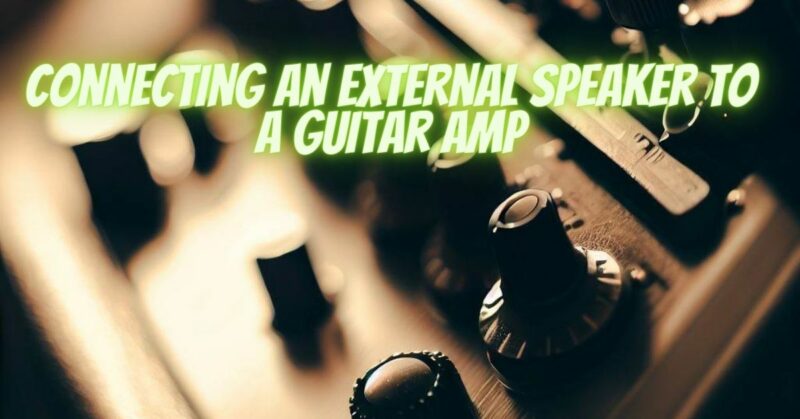As a guitarist, you may find yourself seeking ways to enhance your sound and expand your sonic possibilities. One effective method is connecting an external speaker to your guitar amp. By doing so, you can achieve a broader tonal range, increased volume, and greater coverage. In this informative article, we explore the process of connecting an external speaker to your guitar amp, providing step-by-step instructions and insights for an enriched musical experience.
Understanding the Benefits of an External Speaker: Connecting an external speaker to your guitar amp offers several advantages:
- Expanded Tonal Palette: By adding an external speaker, you can influence the overall sound and tone of your guitar amp. Different speaker models and configurations provide varying frequency responses, resonance characteristics, and tonal nuances, allowing you to tailor your sound to your preferences.
- Increased Volume and Projection: An external speaker can significantly boost your amp’s volume and projection. Whether you’re performing in a larger venue or simply want to add more oomph to your sound, an external speaker can help you achieve the desired impact.
- Customization and Versatility: With the ability to connect different speaker cabinets, you gain the flexibility to experiment with various setups. This customization allows you to adapt to different playing styles, genres, and performance environments, ensuring your sound remains dynamic and adaptable.
Connecting an External Speaker to Your Guitar Amp: Follow these step-by-step instructions to connect an external speaker to your guitar amp:
- Check the Amp’s Speaker Output Options: Ensure that your guitar amp has a dedicated speaker output or an external speaker jack. Consult the amp’s manual or manufacturer’s website for specific details.
- Verify Speaker Impedance: Confirm the speaker impedance requirements of your guitar amp. It is crucial to match the speaker impedance to that specified by the amp’s manufacturer to prevent damage and ensure optimal performance.
- Select an External Speaker: Choose an external speaker cabinet that complements your desired tonal characteristics, power handling, and size requirements. Consider factors such as speaker size, construction, and the number of speakers in the cabinet.
- Connect the External Speaker: a. Power Off: Before making any connections, switch off your guitar amp and unplug it from the power source for safety. b. Speaker Output: Locate the speaker output jack on your guitar amp. It is typically labeled “External Speaker” or similar. c. Speaker Cable: Connect one end of a speaker cable to the speaker output jack on your amp. d. Speaker Cabinet: Connect the other end of the speaker cable to the input jack on the external speaker cabinet.
- Check the Speaker Cabinet Impedance: Ensure that the speaker cabinet’s impedance matches the requirements of your guitar amp. It is crucial to avoid mismatched impedance, as it can damage your amp or negatively impact the sound quality.
- Power On and Test: a. Power on your guitar amp and gradually increase the volume. b. Strum your guitar and listen for the sound emanating from the external speaker cabinet. c. Adjust the amp’s EQ and settings to optimize the sound and tonal balance.
Important Considerations: When connecting an external speaker to your guitar amp, keep the following considerations in mind:
- Impedance Matching: Ensure that the speaker cabinet’s impedance matches the requirements specified by your amp’s manufacturer to avoid potential damage and achieve optimal performance.
- Power Handling: Be mindful of the power handling capabilities of both your guitar amp and the external speaker cabinet to prevent overpowering or damaging the speakers.
- Safety First: Always power off and unplug your amp before making any connections to ensure your safety and protect the equipment from accidental damage.
Connecting an external speaker to your guitar amp opens up a world of tonal possibilities, increased volume, and customization. By following these step-by-step instructions and considering important factors like impedance matching and power handling, you can successfully incorporate an external speaker into your setup. Enjoy the expanded soundscapes, the enhanced projection, and the versatility that an external speaker brings to your guitar playing journey.

